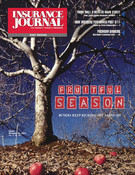Insurance companies played the largest role in compensating people and businesses hurt by the Sept. 11 attacks, paying slightly more than half of the $38.1 billion in benefits, according to a recent study.
The results raise questions about the future role of insurance companies in response to any attack, said Lloyd Dixon, who co-authored the study for the Rand Institute for Social Justice.
“It points out the hole that would be created if we don’t have terrorism insurance,” Dixon said. “What if the insurers weren’t there the next time?”
The federal guarantee–the Terrorism Risk Insurance Act (TRIA)–that protects insurance companies against major financial losses in the event of another attack is set to expire at the end of 2005, and some in Congress are pressing for an extension now to keep premiums down.
Opportune time
Rand notes that TRIA’s pending sunset presents an opportune time to evaluate what role the government should play, because without an extension or substitute program, insurers will not be in the market for catastrophic terrorism coverage.
“While the Rand study makes compelling points for ultimately finding a long-term solution to the challenges of insuring against catastrophic terror, we want to emphasize the urgency of getting TRIA extended as soon as possible,” said Leigh Ann Pusey, senior vice president for the American Insurance Association (AIA). “As the study authors note, insurers are now negotiating and underwriting policies that will not expire until after TRIA does. This calendar mismatch is creating dysfunction in the marketplace right now–and the dysfunction will only grow until Congress acts.”
The 173-page report found that insurers paid about $19.6 billion (or 51 percent of the total victim compensation paid) to private entities, while the government gave $15.8 billion or 42 percent, and charities $2.7 billion, or 7 percent.
Majority to businesses
The majority of benefits (61 percent) went to New York City businesses, which received $23.3 billion, according to Rand. Three out of every four dollars that went to businesses came from insurers.
The report notes that the high proportion of benefits going to businesses reflects “both the considerable property damage suffered by businesses in the attacks and the substantial effects of the attacks on the New York City economy.” It notes that individual workers also “indirectly benefited from benefits provided to businesses.”
Business property costs (benefit payments to insureds plus claims adjustment expenses) for insurers have totaled $20.45 billion and break down as follows:
| World Trade Center structure Other commercial property Business interruption Event cancellation |
$3.60 billion $5.40 billion $10.50 billion $0.95 billion |
While the benefits paid by insurers to businesses were huge, the report points out that total property damage to businesses in New York City was estimated to be $16 billion, while insurance payments for property damage there amounted to just $7.5 billion.
Also, while there were payouts for business interruption losses, lost profits were not fully addressed by the various compensation sources.
Civilians killed or injured in the attacks have received an average of $3.1 million per person from government, charity, or insurance payments, for a total of $8.7 billion, the study found.
Emergency personnel killed or injured were given a total of about $1.9 billion.
First responders were given an average of $1.1 million more than civilians with similar economic losses, the study found. Most of the extra money came from charities.
In such a large-scale disaster, even the secondary assistance added up to billions of dollars in compensation. About $3.5 billion was paid to displaced residents, workers who lost their jobs, those who suffered emotional problems, or were exposed to environmental dangers.
Dixon also argued that one of the defining features of the response to Sept. 11 is the relative lack of litigation, which has yet to account for a significant portion of the compensation.
The report notes there are some lawsuits pending from individuals and companies, the outcomes of which will change final figures.
One such case is the ongoing court battle between World Trade Center leaseholder Larry Silverstein and his insurers.
Researchers also did not include the billions in federal dollars allotted for rebuilding lower Manhattan’s infrastructure, because their study focused on payments made to people or businesses.
The Rand Institute for Social Justice report, Compensation for Losses from the 9/11 Terrorist Attacks, can be found at www.rand.org.
Associated Press reports were used in this story. Copyright 2004 Associated Press. All rights reserved. This material may not be published, broadcast, rewritten or redistributed.
Was this article valuable?
Here are more articles you may enjoy.


 BlackSuit Cybercrime Gang Blamed in CDK Hack That Roiled Car Dealers
BlackSuit Cybercrime Gang Blamed in CDK Hack That Roiled Car Dealers  Coverage Needed: Hundreds of Thousands in SE Now in Flood Zones With New Maps
Coverage Needed: Hundreds of Thousands in SE Now in Flood Zones With New Maps  As Rates Rise, Majority of Homeowners Say Insurance Industry Is in Crisis: Survey
As Rates Rise, Majority of Homeowners Say Insurance Industry Is in Crisis: Survey  Zurich to Buy AIG’s Travel Insurance Business for $600 Million
Zurich to Buy AIG’s Travel Insurance Business for $600 Million 


